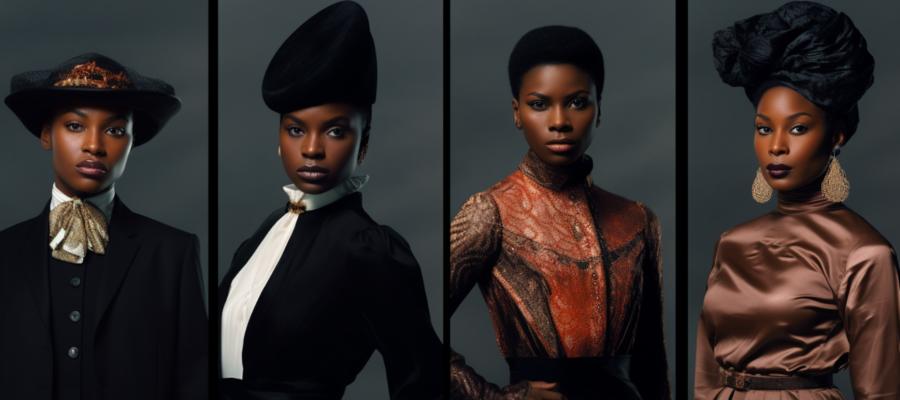The Evolution of Black Fashion

From Headwraps to Hightops
Imagine, for a moment, a world where fashion is more than just the clothes you wear. It's a statement of your identity, your history, and your very essence. This, my friends, is the world of black fashion. From humble beginnings to haute couture, African American fashion has evolved in unexpected and fascinating ways. So, grab your favorite pair of bell-bottoms and join me on a psychedelic journey through the ages of black fashion.Slave Garments: A Forced Beginning
The story of black fashion begins in the 17th and 18th centuries, when African slaves were brought to the Americas. Forced to wear tattered rags and sometimes nothing at all, clothing—or lack thereof—became a symbol of oppression. But despite their circumstances, the enslaved Africans still found ways to express their culture and identity. They would twist and tie their headwraps in unique ways, representing different tribes and regions from which they hailed. These headwraps served not only as a badge of identity but also as a subtle act of resistance against their oppressors.The Blooming of Black Fashion: 19th Century and Beyond
As more African Americans gained their freedom, they began to experiment with fashion, incorporating European and African styles. The result was a unique fusion of cultures, with black men and women creating their own sense of style and beauty. In the late 1800s, the "Sunday Best" became a popular trend among freed slaves, who would dress in their finest clothes on Sundays as an expression of their newfound freedom and status.As we venture into the 20th century, black fashion exploded into a multitude of styles and movements. Let's take a look at some of the most iconic moments in black fashion history.
The Harlem Renaissance: A Time of Elegance
The Harlem Renaissance was a glorious period of black cultural expression and pride, and fashion played a key role. The 1920s and 1930s saw black men and women embracing European styles, with tailored suits, flapper dresses, and elegant accessories. At the same time, they infused their outfits with African prints and bright colors, creating a unique and sophisticated aesthetic that still inspires today. This was a time when black fashion icons like Josephine Baker and Duke Ellington claimed their rightful place in the world of high fashion and further propelled the visibility of black style.The Civil Rights Era: Fashion as a Weapon
During the Civil Rights Movement of the 1950s and 1960s, black fashion took on a new significance. Clothing and personal style became powerful tools for asserting black identity, pride, and resistance against racism. The Black Panthers, for example, adopted a uniform of black leather jackets, black pants, and black berets—a symbol of unity and defiance against their oppressors.Meanwhile, everyday black men and women used their fashion choices to send a message, often incorporating traditional African garments and accessories into their outfits, such as the dashiki and the Afro pick. These bold statements of black beauty and heritage were a direct challenge to the mainstream fashion industry, which often excluded or marginalized black people.
The 70s and 80s: Disco, Hip-Hop, and Black Fashion Icons
The 1970s and 1980s saw an explosion of black fashion creativity and innovation, as well as the rise of several prominent black fashion icons, such as Diana Ross, Grace Jones, and Michael Jackson. Disco fashion brought us the legendary bell-bottoms, platform shoes, and shiny polyester suits, while hip-hop fashion introduced us to tracksuits, oversized gold chains, and, of course, the beloved hightops. This was also the era of the "Black is Beautiful" movement, which celebrated black features like full lips, dark skin, and natural hair, pushing back against Eurocentric beauty standards.Modern Black Fashion: A Continuation of Excellence
Today, black fashion continues to push boundaries and challenge societal norms. From the futuristic designs of Telfar Clemens to the boundary-breaking gender-fluid styles of Billy Porter, black fashion is continuously evolving and redefining what it means to be stylish and beautiful. As more black designers take the helm of major fashion houses, like Virgil Abloh at Louis Vuitton and Olivier Rousteing at Balmain, we can expect to see even more innovation and excellence from the world of black fashion in the coming years.In Conclusion: The Threads That Bind Us All
From headwraps to hightops, the evolution of black fashion is a captivating tale of resilience, creativity, and self-expression. The diverse styles and movements that have emerged over the centuries are a testament to the strength and adaptability of black people, who have used fashion not only to make a statement but also to reclaim their history and identity. And at the end of the day, isn't that what fashion is all about?Article kindly provided by foreverinfashion.org
Latest Articles
- Style That Works With Your Body, Not Against It
- Fashion Tourism on Wheels: Curated Shopping Routes Led by Chauffeur Guides
- The Charm of Certainty in a World of Indecision
- Can an Everyday T-Shirt Be Turned into a Modern Heirloom?
- Color, Ceremony, and the Psychology of Celebration
- Styling Graphic T-Shirts for Different Body Types
- Getting Kids to Wear Their Hats Without a Bribe or a Meltdown
- Mastering the Art of Being the Unnoticed Photographer
- Quiet Sportswear Moves Loudly
- Fashion's Most Misunderstood Color Is Brown
- Weight Matters When Cotton Gets Real
- SKU's Out for Summer: Why Your Warehouse Is Melting Down
- Ink as Accessory - How Tattoos Are Replacing Jewelry in Modern Style
- Decoding the Y2K Aesthetic with Style and Sanity
- Accessories
- Jewellery
- Footwear
- Skirts and Dresses
- Shirts and Blouses
- Beauty and Makeup
- Fashion Photography
- Sustainable Fashion
- Street Style
- Fashion History
- Fashion Business
- Fashion Styling
- Fashion Events
- Plus-Size Fashion
- Men's Fashion
- Women's Fashion
- Fashion Blogging
- Fashion Trends
- Fashion Retailers
- Fashion Tips and Advice
- Fashion Business Startups
- Fashion Around the World
- Lingerie
- Sportswear
- Weddings

